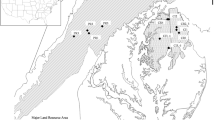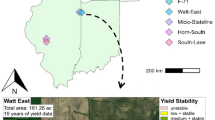Abstract
Our current understanding of the mechanisms driving spatiotemporal yield variability in rice systems is insufficient for effective management at the sub-field scale. The overall objective of this study was to evaluate the potential of precision management for rice production. The spatiotemporal properties of multiyear yield monitor data from four rice fields, representing varying soil types and locations within the primary rice growing region in California, were quantified and characterized. The role of water management, land-leveling, and the spatial distribution of soil properties in driving yield heterogeneity was explored. Mean yield and coefficient of variation at the sampling points within each field ranged from 9.2 to 12.1 Mg ha−1 and from 7.1 to 14.5 %, respectively. Using a k-means clustering and randomization method, temporally stable yield patterns were identified in three of the four fields. Redistribution of dissolved organic carbon, nitrogen, potassium and salts by lateral flood water movement was observed across all fields, but was only related to yield variability via exacerbating areas with high soil salinity. The effects of cold water temperature and land-leveling on yield variability were not observed. Soil electrical conductivity and/or plant available phosphorus were identified as the underlying causes of the within-field yield patterns using classification and regression trees. Our results demonstrate that while the high temporal yield variability in some rice fields does not permit precision management, in other fields exhibiting stable yield patterns with identifiable causes, precision management and modified water management may improve the profitability and resource-use efficiency of rice production systems.











Similar content being viewed by others
References
Bakhsh, A., Jaynes, D. B., Colvin, T. S., & Kanwar, R. S. (2000). Spatio-temporal analysis of yield variability for a corn-soybean field in Iowa. Transactions of the ASAE, 43(1), 31–38.
Basso, B., Bertocco, M., Sartori, L., & Martin, E. C. (2007). Analyzing the effects of climate variability on spatial pattern of yield in a maize–wheat–soybean rotation. European Journal of Agronomy, 26(2), 82–91.
Bivand, R., Altman, M., Anselin, L., Assunção, R., Berke, O., Bernat, A., et al. (2010). Spdep: spatial dependence: weighting schemes, statisitics and models. R package version 0.5-21. http://CRAN.R-project.org/package=spdep. Accessed 31 Aug 2010.
Brye, K. R. (2006). Soil biochemical properties as affected by land leveling in a clayey aquert. Soil Science Society of America Journal, 70(4), 1129–1139.
Burt, R. (2004). Soil survey laboratory methods manual. SSIR No. 42, Version 4.0. NRCS-USDA. Washington, DC: U.S. Government Printing Office.
Casanova, D., Goudriaan, J., Bouma, J., & Epema, G. F. (1999). Yield gap analysis in relation to soil properties in direct-seeded flooded rice. Geoderma, 91(3–4), 191–216.
Cassman, K. G. (1999). Ecological intensification of cereal production systems: Yield potential, soil quality, and precision agriculture. Proceedings of the National Academy of Sciences, USA, 96(11), 5952–5959.
Clesceri, L. S., Greenberg, A. E., & Eaton, A. D. (Eds.). (1998). Standard methods for the examination of water and wastewater, flow injection analysis for orthophosphate (method 4500-P G) (20th ed., pp. 4-149–4-150). Washington, DC: American Public Health Association.
De Datta, S. K., & Mikkelson, D. S. (1985). Potassium nutrition of rice. In R. D. Munson (Ed.), Potassium in Agriculture (pp. 665–669). Madison, WI: ASA, CSSA, and SSSA.
Delmotte, S., Tittonell, P., Mouret, J. C., Hammond, R., & Lopez-Ridaura, S. (2011). On farm assessment of rice yield variability and productivity gaps between organic and conventional cropping systems under mediterranean climate. European Journal of Agronomy, 35(4), 223–236.
Dimitriadou, E., Hornik, K., Leisch, F., Meyer, D., & Weingessel, A. (2010). e1071: Misc functions of the department of statistics (e1071), TU Wien. R package version 1.5-24. http://CRAN.R-project.org/package=e1071. Accessed 15 Feb 2012.
Doane, T. A., & Horwath, W. R. (2003). Spectrophotometric determination of nitrate with a single reagent. Analytical Letters, 36(12), 2713–2722.
Dobermann, A. (1994). Factors causing field variation of direct-seeded flooded rice. Geoderma, 62(1–3), 125–150.
Eck, H. V. (1987). Characteristics of exposed subsoil—at exposure and 23 years later. Agronomy Journal, 79(6), 1067–1073.
Flowers, T. J., & Yeo, A. R. (1981). Variability in the resistance of sodium chloride within rice (Oryza sativa L.) varieties. New Phytologist, 88(2), 863–1373.
Forster, J. C. (1995). Soil nitrogen. In K. Alef & P. Nannipieri (Eds.), Methods in applied soil microbiology and biochemistry (pp. 79–87). New York: Academic Press.
Guastaferro, F., Castrignanó, A., De Benedetto, D., Sollitto, D., Troccoli, A., & Cafarelli, B. (2010). A comparison of different algorithms for the delineation of management zones. Precision Agriculture, 11(6), 600–620.
Harris, D., Horwath, W. R., & van Kessel, C. (2001). Acid fumigation of soils to remove carbonates prior to total organic carbon or CARBON-13 isotopic analysis. Soil Science Society of America Journal, 65(6), 1853–1856.
Hofer, S. (2003). Determination of ammonia (salicylate) in 2 M KCl soil extracts by flow injection analysis. QuikChem method 12-107-06-2-A. Loveland: Lachat Instruments.
Khatun, S., & Flowers, T. J. (1995). Effects of salinity on seed set in rice. Plant, Cell and Environment, 18(1), 61–67.
Knepel, K. (2003). Determination of nitrate in 2 M KCl soil extracts by flow injection analysis. QuikChem method 12-107-04-1-B. Loveland: Lachat Instruments.
Lark, R. M., & Stafford, J. V. (1997). Classification as a first step in the interpretation of temporal and spatial variation of crop yield. Annals of Applied Biology, 130(1), 111–121.
Linquist, B., & Ruark, M. (2011). Re-evaluating diagnostic phosphorus tests for rice systems based on soil phosphorus fractions and field level budgets. Agronomy Journal, 103(2), 501–508.
Lutts, S., Kinet, J. M., & Bouharmont, J. (1995). Changes in plant response to NaCl during development of rice (Oryza sativa L.) varieties differing in salinity resistance. Journal of Experimental Botany, 46(12), 1843–1852.
Maas, E. V. (1990). Crop salt tolerance. In K. K. Tanji (Ed.), Agricultural salinity assessment and management manual (pp. 262–304). New York: American Society of Civil Engineers (ASCE) Manuals & Reports on Engineering Practices No. 71.
Maas, E. V., & Grattan, S. R. (1999). Crop yields as affected by salinity. In R. W. Skaggs & J. van Schilfgaarde (Eds.), Agricultural drainage. Agronomy Monograph No. 38 (pp. 55–108). Madison, WI: ASA and SSSA.
Maas, E. V., & Hoffman, G. J. (1977). Crop salt tolerance—current assessment. Journal of Irrigation and Drainage Engineering, American Society of Civil Engineers, 103(2), 115–134.
Miranda, K. M., Espey, M. G., & Wink, D. A. (2001). A rapid, simple spectrophotometric method for simultaneous detection of nitrate and nitrite. Nitric Oxide, 5(1), 62–71.
Mzuku, M., Khosla, R., Reich, R., Inman, D., Smith, F., & MacDonald, L. (2005). Spatial variability of measured soil properties across site-specific management zones. Soil Science Society of America Journal, 69(5), 1572–1579.
Olsen, S. R., & Sommers, L. E. (1982). Phosphorus. In A. L. Page, R. H. Miller, & D. R. Keeney (Eds.), Methods of soil analysis, Part 2: Chemical and microbiological properties. Agronomy Mongraph No. 9 (2nd ed., pp. 403–430). Madison, WI: ASA and SSSA.
Perez-Quezada, J. F., Pettygrove, G. S., & Plant, R. E. (2003). Spatial-temporal analysis of yield and the influence of soil factors in two four-crop-rotation fields in the Sacramento Valley, California. Agronomy Journal, 95(3), 676–687.
Raney, F. C., Hagan, R. M., & Finfrock, D. C. (1957). Water temperature in irrigation. California Agriculture, 11(4), 19–20.
Rao, P. S., Mishra, B., Gupta, S. R., & Rathore, A. (2008). Reproductive stage tolerance to salinity and alkalinity stresses in rice genotypes. Plant Breeding, 127(3), 256–261.
Maclean, J. L., Dawe, D. C., Hardy, B., & Hettel, G. P. (Eds.). (2002). Rice almanac (3rd ed). Wallingford: CABI Publishing and Los Baños.
Roel, A., Mutters, R. G., Eckert, J. W., & Plant, R. E. (2005). Effect of low water temperature on rice yield in California. Agronomy Journal, 97(3), 943–948.
Roel, A., & Plant, R. E. (2004a). Spatiotemporal analysis of rice yield variability in two California fields. Agronomy Journal, 96(1), 77–90.
Roel, A., & Plant, R. E. (2004b). Factors underlying yield variability in two California rice fields. Agronomy Journal, 96(5), 1481–1494.
Scardaci, S. C., Shannon, M. C., Grattan, S. R., Eke, A. U., Roberts, S. R., Goldman-Smith, S., et al. (2002). Water management practices can affect salinity in rice fields. California Agriculture, 56(6), 184–188.
Shannon, M. C., Rhoades, J. D., Draper, J. H., Scardaci, S. C., & Spyres, M. D. (1998). Assessment of salt tolerance in rice cultivars in response to salinity problems in California. Crop Science, 38(2), 394–398.
Shimono, H. T., Hasegawa, T., Fujimura, S., & Iwama, K. (2004). Responses of leaf photosynthesis and plant water status in rice to low water temperature at different growth stages. Field Crops Research, 89(1), 71–83.
Shimono, H. T., Hasegawa, T., & Iwama, K. (2002). Responses of growth and grain yield in paddy rice to cool water at different growth stages. Field Crops Research, 73(2–3), 67–79.
Shimono, H., Okada, M., Kanda, E., & Arakawa, I. (2007). Low temperature-induced sterility in rice: Evidence for the effects of temperature before panicle initiation. Field Crops Research, 101(2), 221–231.
Therneau, T. M., & Atkinson, B. (2009). R port by brian ripley. rpart: recursive partitioning. R package version 3.1-45. http://CRAN.R-project.org/package=rpart. Accessed 15 Feb 2012.
Thomas, G. W. (1982). Exchangeable cations. In A. L. Page, R. H. Miller, & D. R. Keeney (Eds.), Methods of soil analysis: Part 2. Chemical and microbiological properties. Agronomy monograph 9 (2nd ed., pp. 159–165). Madison, WI: ASA and SSSA.
U.S. Environmental Protection Agency Method 200.7. (2001). Trace elements in water, solids, and biosolids by inductively coupled plasma-atomic emission spectrometry. Washington, DC: U.S. EPA.
Verdouw, H., Van Echteld, C. J. A., & Dekkers, E. M. J. (1978). Ammonia determination based on indophenol formation with sodium salicylate. Water Research, 12(6), 399–402.
Waggoner, P. E., & Aylor, D. E. (2000). Epidemiology, a science of patterns. Annual Review of Phytopathology, 38(1), 71–94.
Walker, T. W., Kingery, W. L., Street, J., Cox, M. S., Oldham, J. L., Gerard, P. D., et al. (2003). Rice yield and soil chemical properties as affected by precision land-leveling in alluvial soils. Agronomy Journal, 95(6), 1483–1488.
Wehlan, B. M., & McBratney, A. B. (2000). The “null hypothesis” of precision agriculture management. Precision Agriculture, 2(3), 265–279.
Williams, J. F. (2010). Rice nutrient management in California. Publ. 3516. California: University of California, Agriculture and Natural Resources.
Yanai, J., Lee, C. K., Kaho, T., Iida, M., Matsui, T., Umeda, M., et al. (2001). Geostatistical analysis of soil chemical properties and rice yield in a paddy field and application to the analysis of yield-determining factors. Soil Science and Plant Nutrition, 47(2), 291–301.
Acknowledgments
This research was supported by the Kearney Foundation of Soil Science; William G. and Kathleen Golden International Agriculture Fellowship; Henry A. Jastro Graduate Research Award; D. Marlin Brandon Rice Research Fellowship; and the Ben A. Madson Scholarship. Additionally, the research of J.M. Peña-Barragan was granted by the Fulbright-MEC postdoctoral program, financed by the Secretariat of State for Research of the Spanish Ministry for Science and Innovation. We thank the cooperating growers, George Tibbitts, Larry Maben and Charley Mathews for allowing us to conduct research on their farms. We are very grateful to the Agroecosystems Lab Manager, Cesar Abrenilla, as well as Kristen Kammeier, Denia Rodriguez Piza, Tim Doane, Ligia Azevedo, Bob Rousseau and numerous members of the Agroecosystems Lab at UC Davis for their assistance in the field and lab.
Author information
Authors and Affiliations
Corresponding author
Rights and permissions
About this article
Cite this article
Simmonds, M.B., Plant, R.E., Peña-Barragán, J.M. et al. Underlying causes of yield spatial variability and potential for precision management in rice systems. Precision Agric 14, 512–540 (2013). https://doi.org/10.1007/s11119-013-9313-x
Published:
Issue Date:
DOI: https://doi.org/10.1007/s11119-013-9313-x




